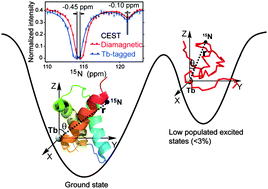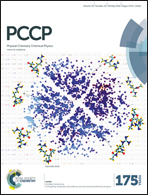Determination of pseudocontact shifts of low-populated excited states by NMR chemical exchange saturation transfer†
Abstract
Despite the critical roles of excited states in protein functions, they remain intractable for most structural studies because of their notably low populations. Chemical shifts for “invisible” states in slow exchange with the ground state are intuitively observed using nuclear magnetic resonance (NMR) chemical exchange saturation transfer (CEST) experiments. Here, we present a CEST NMR spectroscopy study for the observation of protein pseudocontact shifts (PCSs) of excited states, which carry valuable angular and distance information about these states. We first validate this approach, dubbed PCS–CEST, in the slow-exchange system of Abp1p SH3-Ark1p labeled with lanthanide ions, where the PCSs of the minor states resemble those of the holo-form ground state as expected. We further demonstrate that pre-existing folding transitional conformations of an FF domain exhibit remarkably lower PCS values than the ground state, which suggests that the low-populated ensemble is unfolded or largely unfolded. A higher resolution of PCSs of the minor states is achieved using our 1D selective CEST experiments. Thus, PCS–CEST provides an exquisite structural probe into the minor but functionally essential excited states.


 Please wait while we load your content...
Please wait while we load your content...